|
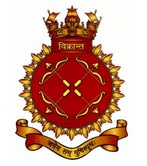 In
a colourful ceremony filled with traditional pomp
and fervour at the Cochin Shipyard Limited (CSL)
here, Mrs Elizabeth Antony, wife of Defence Minister
AK Antony, launched the imposing vessel and christened
it as INS Vikrant. In
a colourful ceremony filled with traditional pomp
and fervour at the Cochin Shipyard Limited (CSL)
here, Mrs Elizabeth Antony, wife of Defence Minister
AK Antony, launched the imposing vessel and christened
it as INS Vikrant.
Present on the occasion were Mr Antony, Shipping
Minister GK Vasan, Chief of Naval Staff Admiral
DK Joshi, Western Naval Command Commander in Chief
Vice Admiral Shekhar Sinha, Southern Naval Command
Commander in Chief Vice Admiral Satish Soni, CSR
Chairman and Managing Director Commodore (Retd)
K Subramaniam and other officials of the Ministries
of Defence and Shipping.
A multitude of Naval officers, yard workers
and some members of the Steel Authority of India
Limited (SAIL), the manufacturers of the indigenous
warship grade steel, were also present.
The new carrier, which will be operational in
2018, derives its name from India’s first
Majestic Class aircraft carrier, Hercules, which
was acquired from Britain in 1957, commissioned
in 1961 as INS Vikrant, and decommissioned in
1997. In the naval traditions, names of various
ships are passed on to successor vessels.
At the launch, marking the end of Phase- I of
the project, the imposing ramp of the 37,500 tonne
Short Take off but Assisted Recovery (STOBAR)
Carrier boasted the indigenous design and build
capabilities of the country.
The ship has attained its designed length of
about 260 m and is almost at its maximum breadth
of 60 m. The main landing strip is ready.
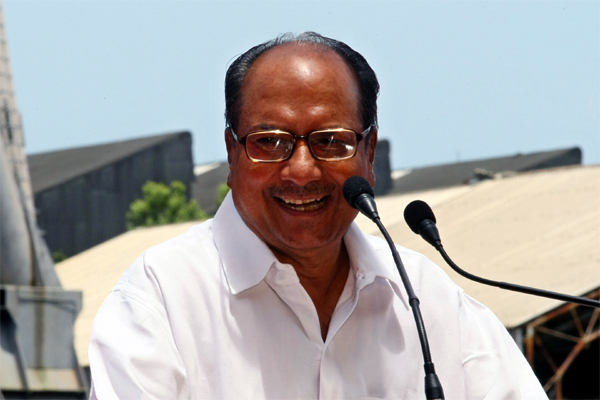
Over 80 per cent of the structure, containing
about 2,300 compartments has been fabricated,
over 75 per cent has been erected, all the major
machinery, such as the two LM2500 Gas Turbines
developing a total power of 80 MW, the diesel
alternators capable of producing about 24 MW and
the main gear box have been fitted.
Soon after Vikrant floated perfectly upright,
it was launched out into the Ernakulam Channel
in a pontoon assisted precision manoeuvre. Vikrant
was moved out of the building dock to be positioned
in the refitting dock where the next Phase of
outfitting will be completed.
Describing the occasion as ‘momentous’,
Mr Antony said,“ Today’s launching of
the IAC marks just the first step in a long journey,
but at the same time, an important one.”
He said it was indeed a proud moment for the
country to witness our efforts at achieving self-reliance
in the field of warship design and construction,
as only a very few advanced countries in the world
possess the capability to design and build aircraft
carriers.
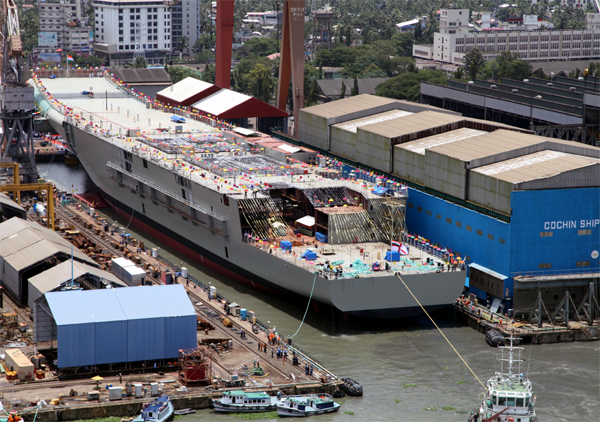
India must continue the process of strengthening
indigenous capability towards securing our maritime
interests. ‘Our Navy must continue to maintain
high operational readiness at all times to ward
off any likely misadventure against our national
interests’, he said.
The Defence Minister urged the Indian industry
to participate whole-heartedly in the country’s
shipbuilding programmes and further consolidate
“our strength in this field.”
Speaking on the occasion, Shipping Minister
Vasan said that by launching this great warship,
which is one of the most important ships for the
Indian Navy, Indian shipbuilding has demonstrated
its technical capability and expertise.
(Significantly, CSL is a state-run facility
under the Ministry of Shipping. It is now set
to build other bigger ships, including India’s
second aircraft carrier which should be 60,000
tonnes-plus).
The design and construction of the Indigenous
Aircraft Carrier was sanctioned by the government
in January 2003. The keel of the ship was laid
on 28 Feb 2009 by Mr Antony.
INS Vikrant marks a special feather in indigenous
defence capabilities, this being the first ever
aircraft carrier to be designed by the Directorate
of Naval Design of the Indian Navy, the first
warship to be built by CSL and the first warship
to be built entirely using indigenously produced
steel.
The construction of the ship is a truly pan Indian
effort with active participation of private and
public enterprises. The steel has come from SAIL’s
plants in Raurkela in Orissa, Bokaro in Jharkand
and Bhilai in Chattisgarh, the Main Switch Board,
steering gear and water tight hatches have been
manufactured by Larsen and Toubro in its plants
in Mumbai and Talegaon, the high capacity air
conditioning and refrigeration systems have been
manufactured in Kirloskar’s plants in Pune
and most pumps have been supplied by Best and
Crompton, Chennai.
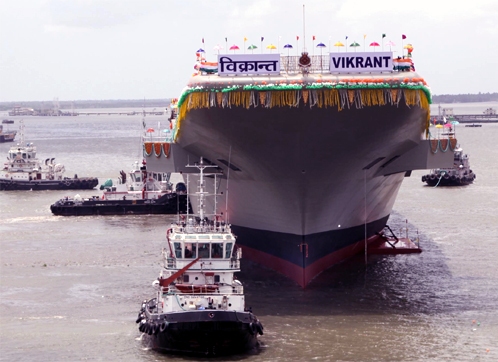
Bharat Heavy Engineering Limited (BHEL) is supplying
the Integrated Platform Management System (IPMS),
the massive gear box is supplied by Elecon in
Gujarat, the tens of thousands of electrical cables
are supplied by Nicco industries in Kokatta, and
Kolkatta is also where the ship’s anchor
chain cable is manufactured.
INS Vikrant will be capable of operating an
aircraft mix of the Russian MiG-29K and LCA (Navy)
fighters being developed indigenously by HAL.
Its helicopter component will include the Kamov
31 and the indigenously developed ALH helicopters.
The ship’s ability to sense and control
a large air space around it will be enabled by
modern C/D band Early Air Warning Radar, V/UHF
Tactical Air Navigational and Direction Finding
systems, jamming capabilities over the expected
Electro Magnetic (EM) environment and Carrier
Control Approach Radars to aid air operations.
Long Range Surface to Air Missile (LR SAM) systems
with Multi-Function Radar (MFR) and Close- In
Weapon System (CIWS) will form the protective
suite of the ship. All weapon systems onboard
the carrier will be integrated through an indigenous
Combat Management System (CMS), being manufactured
by Tata Power systems. The ship’s integration
with Navy’s Network Centric Operations will
provide force multiplication.
Design of this prestigious ship has been undertaken
by the Directorate of Naval Design (DND) of the
Indian Navy.
Created in 1956 as the Corps of Naval Constructors,
to realise the dream of being a builder’s
Navy through indigenisation, DND has successfully
designed over 17 different classes of warships,
to which around 90 ships have already been built
within the country.
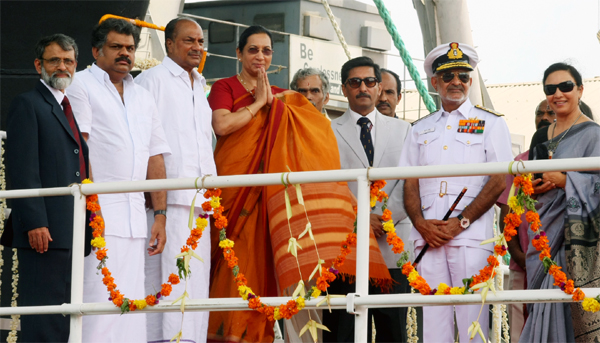
The Delhi class destroyers, with a displacement
of about 7000 tonnes, were the biggest warships
designed by DND so far. Designing of the Vikrant,
at almost 40,000 tonnes, speaks of the maturing
of the capabilities of DND and represents a feather
in the cap of the designers particularly as it
is the first aircraft carrier of its size in the
world with some unique features such as Gas Turbine
Propulsion.
The seamless hull and smooth lines of the ship
stand as testimony to the high production standards
of Cochin Shipyard Limited (CSL). CSL, a mini
Ratna PSU, has earned a reputation for quality
construction and timely delivery.
Till now, CSL had the distinction of building
the largest ship in India i.e., 93,500 tonne Aframax
tankers. However, this complex integrated construction
project enabled by a Rs 200 crore infrastructure
augmentation plan involving large cranes, workshops
and heavy duty machinery has seen the shipyard
maturing into a competent warship builder.
INS Vikrant will now enter the second phase
of construction which will see the outfitting
of the ship, fitment of various weapons and sensors,
integration of the gigantic propulsion system
and integration of the aircraft complex (with
the assistance of M/s NDB of Russia). The ship
will then undergo extensive trials before she
is handed over to the Indian Navy by around 2016-17.

About earlier INS VIkrant
It may be recalled that at the time of attaining
our Independence, India’s visionary leaders
saw the centrality of a powerful Navy and set
the Navy on the right course by envisaging an
aircraft carrier battle group.
INS Vikrant, India’s first aircraft carrier
was acquired from Great Britain in 1957 and commissioned
on 4 Mar 1961. In its 36 years of glorious service
INS Vikrant was at the centre of action in the
1971 operations for liberation of Bangladesh.
Having seen many years of service as a CATOBAR
(Catapult Assisted Take Off but Arrested Recovery)
carrier working an angled deck and operating Sea
Hawks, Alizes and Seaking aircraft, INS Vikrant
was transformed into a STOVL carrier to operate
Sea Harrier jump jets.
It was decommissioned on 31 Jan 1997, after
36 years of glorious service under the Indian
ensign. The vessel now serves as a museum in Mumbai.
With the launch of the new Vikrant, the Indian
Navy is well on its way to demonstrate its comfort
with the practiced art of trapped landings and
angled deck operations.
Pix Credit: DPR
|